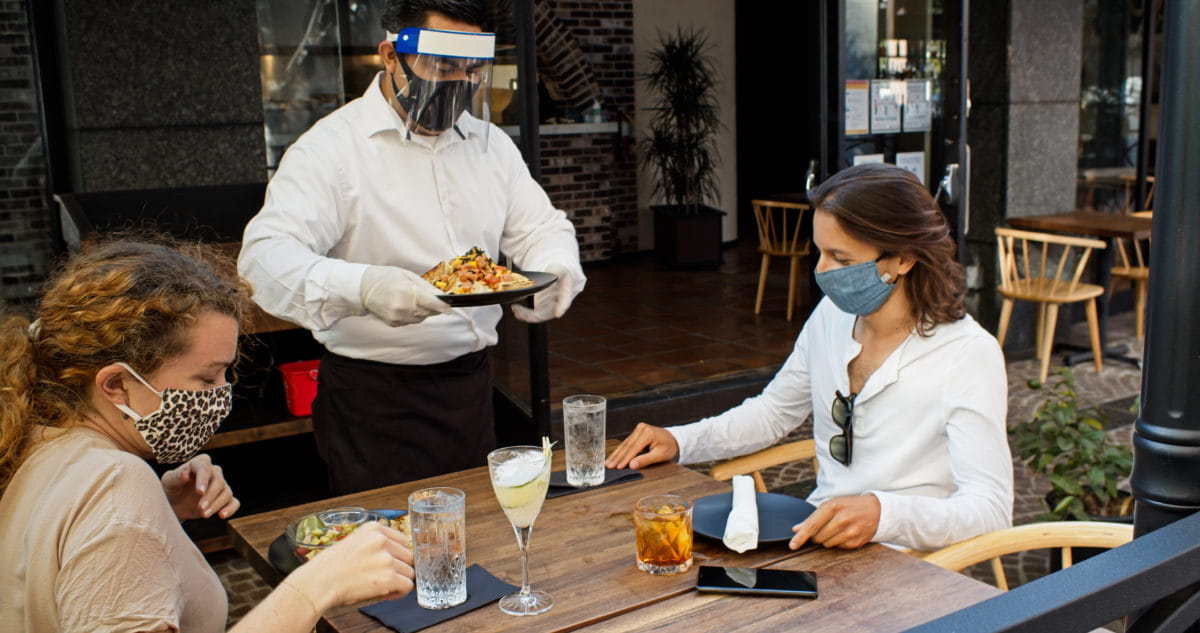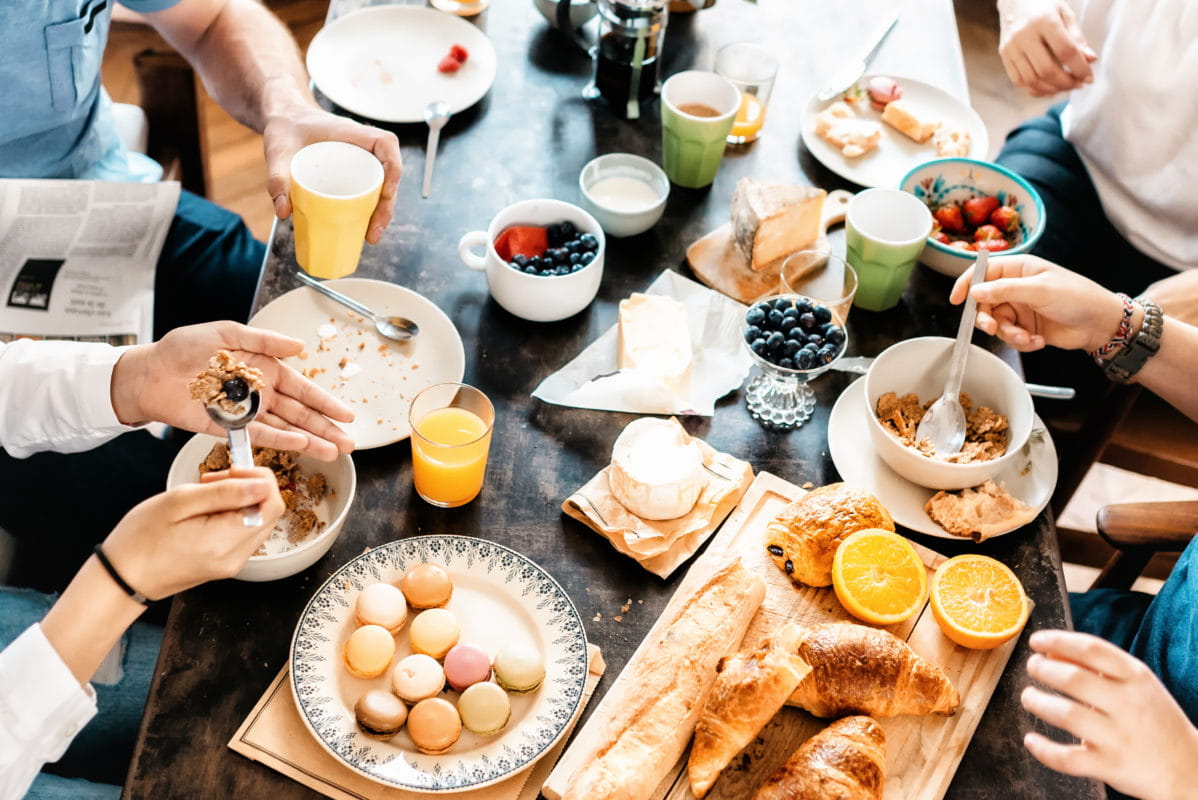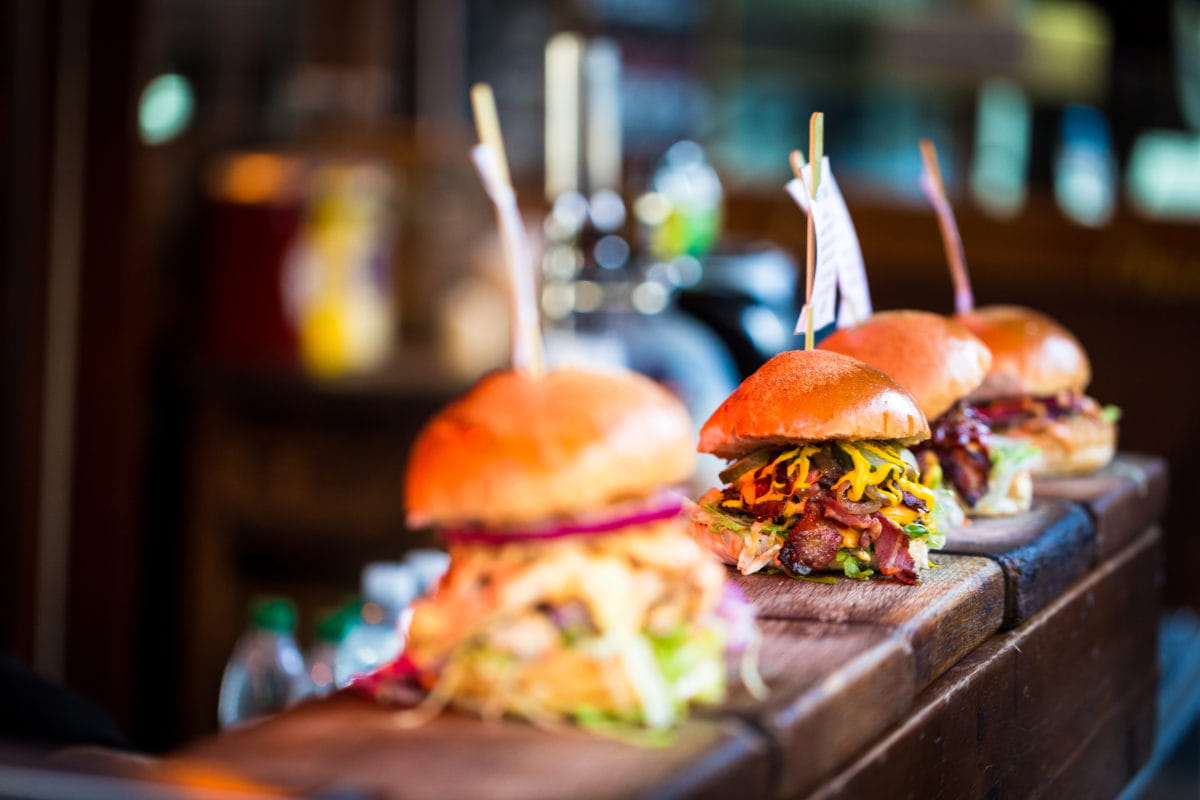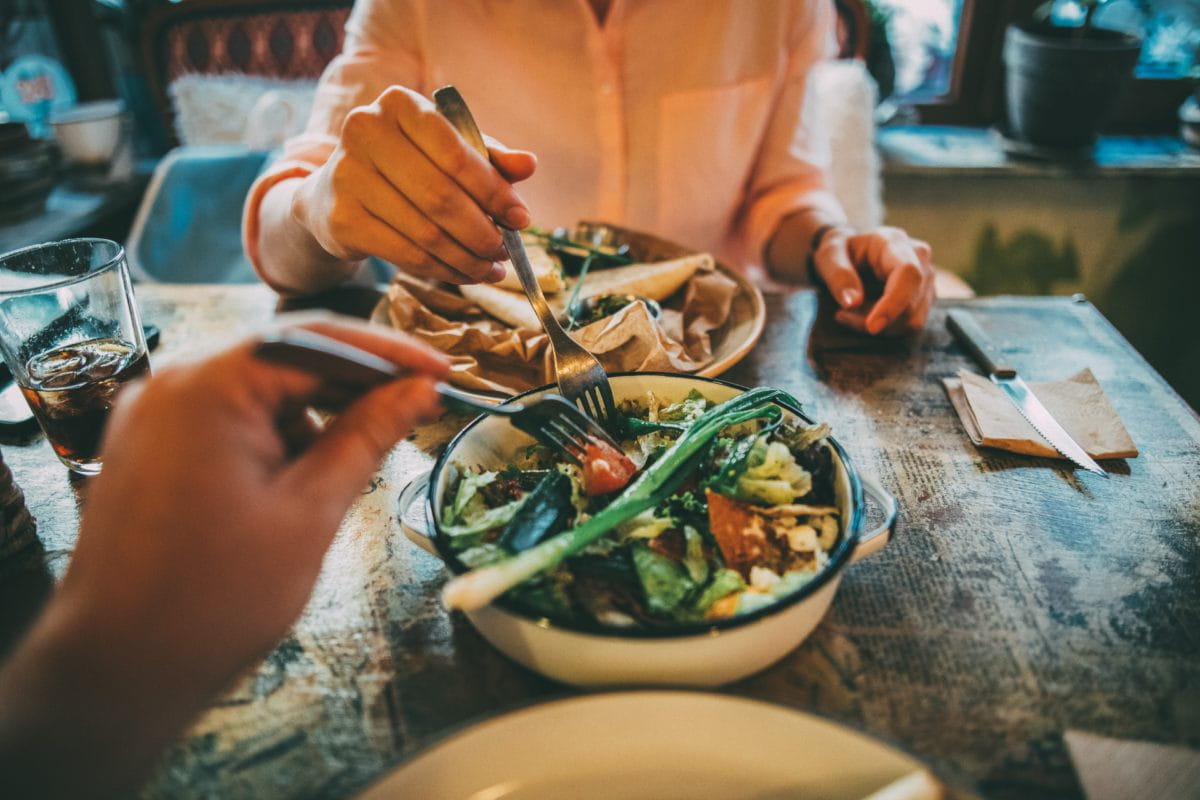Dining Out: Spotting Pandemic Trends and Moving Forward
August 12, 2020
Click Here for the full report!
What we once knew as dining as usual has taken a drastic shift in the past months. Foodservice operators have been forced to think on their feet, quickly adapting and innovating to stay afloat. What trends in the restaurant space can carry over to prepared food and beverage and the grocery aisle? While the effects of the pandemic have negatively impacted the dining industry, it has also brought about innovation in foods, flavors and new ways of dining. From pandemic dining trends to consumer interest in everything from comfort food to spice to and better-for-you offerings, let’s take a look at how this new state of dining has impacted food and flavor trends.

Consumer behaviors and the dining industry changed in what felt like overnight. Shelter-in-place, social distancing and work from home orders limited the extent to which consumers could dine in person, let alone follow common routines such as socializing with friends, picking up their morning coffee on the way to work, buying groceries and more.
From sales declines to food surpluses, the dining industry has been far from “business as usual” with sales down 67% year over year in April. Common dining food and drink such as beer and wine reached sales declines as high as 90% and 65% respectively.
The dining industry response? Adapt to change and innovate with new products, services, and ways of running business.
With COVID-19 restrictions and consumer caution still lingering and even resurging in some areas, dining-in (dining in the comfort of your own home, that is) seems to have become the new dining-out. According to Iconoculture, consumer factors for ordering from restaurants include convenience, variety, a break from cooking, desire for craveable menu items and to support local restaurants.
Months after the pandemic’s emergence, most states have eased restrictions on restaurant dining, either allowing outdoor patio dining or indoor seating in some states throughout the U.S. Added safety precautions such as wearing masks, temperature checks, added sanitation, outdoor patio dining and more have also shifted the dining experience.
Though much has changed, consumers are looking forward to dining at restaurants.
Forced to innovate and adapt, restaurants from fine dining to fast casual alike have shown noteworthy offerings to consumers that may translate to retail. Here are some recent offerings we’ve spotted.
With massive declines in alcohol sales due to dining closure, restaurant operators took to take out drinks as a way to increase sales and provide fun and innovative flavors to consumers. New York’s Please Don’t Tell (PDT) cocktail bar offered cocktails and bar snacks to go. Their “Lit Juice” features Kettle One, Green Apple, Manzanilla, Lemon, Mint and soda.
Playing off the experience factor that comes with dining, many restaurants have started to offer meal kits that allow the consumer to have their favorite restaurant foods straight at home. Taco Bamba offers a taco kit that includes carnitas, spicy mushrooms, Bamba salsa, black beans, rice, pico de gallo and corn tortillas.
The pandemic brought about different ways of purchasing favorite dining groceries, even forming a sort of grocery/dining hybrid that offered common staples consumers could buy from their favorite restaurants. Brewpub Bungalow by Middle Brow in Chicago started selling an assortment of breads, beers and locally sourced produce and grocery items to customers for pickup.
One trend we have spotted throughout all segments of dining, is the introduction of more personalized food offerings that meet consumers’ nutritional needs and dining preferences. The COVID-19 pandemic has amplified consumer focus on health & wellness, increasing interest in “healthier” diet alternatives such as plant-based, low-carb, gluten-free and more. Many restaurants have already hopped on this new consumer need for better-for-you options such as Chipotle Lifestyle Bowls and the abundance of plant-based burger options in fast casual dining. But that doesn’t mean consumers aren’t interested in indulgent and savory offerings. Especially in stressful times, indulgent and savory options aid as a way to unwind.
26% of consumers agree that there are not enough tasty options when it comes to healthy eating. - Mintel
We’ve discussed the popularity of plant-based eating in our Plant-Based Part 1, 2 and 3 reports, and it’s no surprise that it has continued to rise in a time where consumers are concerned about their health. Consumers aren’t only looking at implementing plant-based offerings into their at-home eating, but also in their dining experiences. According to Grubhub’s 2020 report, plant-based orders have increased by a staggering 135% this year alone.
With 42% of consumers eating plant-based for the taste and 56% eating to be healthier, restaurants that can find the sweet spot between taste and health benefit in dining offerings will succeed over those that only prioritize the health factor.
Burger Lounge, a chain in California, offers an organic quinoa veggie burger featuring organic American cheese, fresh or grilled onion, shredded lettuce, tomato, and pickles. The burger is 100% plant-based.
Another hot trend – spicy and savory flavors. Spicy flavors such as habanero and savory flavors such as Za’atar have shown growth this year on restaurant menus. In fact, 29% of consumers agree with the statement “when it comes to spicy, the hotter the better”.
Habanero’s incidence as an ingredient flavor in food increased 81% (Q1 2017-Q1 2020) as well as having
the highest growth out of all of the 100 most common ingredient flavors. From wing sauce to sushi and desserts, this flavor is becoming a common feature in dining offerings.
An example of a savory ingredient, Za’atar, a Middle Eastern spice blend, has shown 53% increase in menu incidences (Q1 2017 – Q1 2020). The spice has shown itself in retail offerings and dining alike, featuring in salmon and tuna steak dishes and more. As for savory offerings, savory pastry products such as crepes and turnovers have showed 51% and 21% growth respectively.
Coasterra Restaurant in San Diego offers a bunuelo cannoli that features goat cheese mousse, grapefruit, and habanero honey.
As consumers were isolated in their homes and many stressed about their health and the future of the economy, they turned to comfort foods to ease their worries. And foodservice operators tapped into this consumer need by offering foods that met their desire to indulge and treat themselves at home.
Chicago’s fine dining restaurant Alinea, which typically costs $300 per person, offered curbside meals that featured comfort foods such as beef Wellington, mashed potatoes and crème brûlée for $35 per person.

For food and beverage developers in the CPG space, there’s one clear takeaway. That is the importance of innovation in food and beverage offerings that center on taste and experience. Additionally, as they wait for the “new-normal” of dining to unfold, consumers want options. Better-for-you, indulgent, and savory offerings all can be successful in the current state as consumers want comfort, but also have concerns for their health. And as we’re likely to see emerging trends as the state of dining transforms, retail offerings can take inspiration from pandemic trends in terms of innovative flavors, convenience and products focused on the experience factor.
Click here for the full report!
What does true partnership look like? You deserve a flavor partner ready to turn these trends into the tangible.
Let FONA’s market insight and research experts get to work for you. Translate these trends into bold new ideas for your brand. Increase market share and get to your “what’s next.” Our technical flavor and product development experts are also at your service to help meet the labeling and flavor profile needs for your products to capitalize on this consumer trend. Let’s mesh the complexities of flavor with your brand development, technical requirements and regulatory needs to deliver a complete taste solution.
From concept to manufacturing, we’re here for you — every step of the way. Contact our sales service department at 630.578.8600 to request a flavor sample or contact us at www.fona.com/contact-fona
Sources in full report
What we once knew as dining as usual has taken a drastic shift in the past months. Foodservice operators have been forced to think on their feet, quickly adapting and innovating to stay afloat. What trends in the restaurant space can carry over to prepared food and beverage and the grocery aisle? While the effects of the pandemic have negatively impacted the dining industry, it has also brought about innovation in foods, flavors and new ways of dining. From pandemic dining trends to consumer interest in everything from comfort food to spice to and better-for-you offerings, let’s take a look at how this new state of dining has impacted food and flavor trends.

Unexpected Changes
Consumer behaviors and the dining industry changed in what felt like overnight. Shelter-in-place, social distancing and work from home orders limited the extent to which consumers could dine in person, let alone follow common routines such as socializing with friends, picking up their morning coffee on the way to work, buying groceries and more.
From sales declines to food surpluses, the dining industry has been far from “business as usual” with sales down 67% year over year in April. Common dining food and drink such as beer and wine reached sales declines as high as 90% and 65% respectively.
The dining industry response? Adapt to change and innovate with new products, services, and ways of running business.
“Restaurant sales declined precipitously throughout the month of March, falling 78.3% from the week ending 8 March to the week ending 29 March. April sales were down 67.6% YoY.” - Iconoculture
“Due to restaurant and bar closures, distributed draft beer sales are down well over 90 percent, according to a BA report from earlier this month. And on-site sales for breweries—much of which comes out of their own tap lines—are down 65 percent on average.” - Food & Wine, April 2020
A New State of Dining
With COVID-19 restrictions and consumer caution still lingering and even resurging in some areas, dining-in (dining in the comfort of your own home, that is) seems to have become the new dining-out. According to Iconoculture, consumer factors for ordering from restaurants include convenience, variety, a break from cooking, desire for craveable menu items and to support local restaurants.
Months after the pandemic’s emergence, most states have eased restrictions on restaurant dining, either allowing outdoor patio dining or indoor seating in some states throughout the U.S. Added safety precautions such as wearing masks, temperature checks, added sanitation, outdoor patio dining and more have also shifted the dining experience.
Though much has changed, consumers are looking forward to dining at restaurants.
- 40% U.S. consumers say going to a restaurant is one of the top three things they are most looking forward to when social distancing measures are relaxed – Mintel
- 47% trust restaurants and bars to take the necessary steps to ensure their health and safety in the future – Magid Study
- 57% of respondents said they expect to visit a restaurant by the fall. – Magid Study
- 71% of U.S. consumers love trying new experiences according to Mintel’s June 2020 Trend Driver research.
Consumer Factors For Ordering From Restaurants Since COVID-19 Outbreak
- Desire to support local restaurants, owners and/or employees
- Variety
- A break from cooking every meal, everyday
- Desire for craveable menu items, which can provide comfort
- Convenience and Immediacy
Pandemic Trends
Forced to innovate and adapt, restaurants from fine dining to fast casual alike have shown noteworthy offerings to consumers that may translate to retail. Here are some recent offerings we’ve spotted.
Cocktails To Go
With massive declines in alcohol sales due to dining closure, restaurant operators took to take out drinks as a way to increase sales and provide fun and innovative flavors to consumers. New York’s Please Don’t Tell (PDT) cocktail bar offered cocktails and bar snacks to go. Their “Lit Juice” features Kettle One, Green Apple, Manzanilla, Lemon, Mint and soda.
Meal Kit Madness
Playing off the experience factor that comes with dining, many restaurants have started to offer meal kits that allow the consumer to have their favorite restaurant foods straight at home. Taco Bamba offers a taco kit that includes carnitas, spicy mushrooms, Bamba salsa, black beans, rice, pico de gallo and corn tortillas.
Dining to Grocery
The pandemic brought about different ways of purchasing favorite dining groceries, even forming a sort of grocery/dining hybrid that offered common staples consumers could buy from their favorite restaurants. Brewpub Bungalow by Middle Brow in Chicago started selling an assortment of breads, beers and locally sourced produce and grocery items to customers for pickup.
Balancing Act
One trend we have spotted throughout all segments of dining, is the introduction of more personalized food offerings that meet consumers’ nutritional needs and dining preferences. The COVID-19 pandemic has amplified consumer focus on health & wellness, increasing interest in “healthier” diet alternatives such as plant-based, low-carb, gluten-free and more. Many restaurants have already hopped on this new consumer need for better-for-you options such as Chipotle Lifestyle Bowls and the abundance of plant-based burger options in fast casual dining. But that doesn’t mean consumers aren’t interested in indulgent and savory offerings. Especially in stressful times, indulgent and savory options aid as a way to unwind.
“Nearly two thirds of US consumers (65%) put a lot of thought into what they eat, meaning they’ll want restaurants to meet them halfway with foods and drinks that make it easy to meet their wellness goals. However, nutritious foods don’t have to lack flavor.” - Mintel
“The percentage of healthy diners is growing…Millennials are the healthiest diners, but Gen Z is the most indulgent, demonstrating the need for a balanced menu.” - Mintel
26% of consumers agree that there are not enough tasty options when it comes to healthy eating. - Mintel
Plant-Based Bites
We’ve discussed the popularity of plant-based eating in our Plant-Based Part 1, 2 and 3 reports, and it’s no surprise that it has continued to rise in a time where consumers are concerned about their health. Consumers aren’t only looking at implementing plant-based offerings into their at-home eating, but also in their dining experiences. According to Grubhub’s 2020 report, plant-based orders have increased by a staggering 135% this year alone.
With 42% of consumers eating plant-based for the taste and 56% eating to be healthier, restaurants that can find the sweet spot between taste and health benefit in dining offerings will succeed over those that only prioritize the health factor.
Offering of Note:
Burger Lounge, a chain in California, offers an organic quinoa veggie burger featuring organic American cheese, fresh or grilled onion, shredded lettuce, tomato, and pickles. The burger is 100% plant-based.
“Similar to Grubhub’s 2019 Year in Food Report, diners are continuing to eat vegan and vegetarian dishes. So far this year, vegan orders have risen by 23%, plant-based burgers specifically increasing by 90% and general plant-based orders by a whopping 135%!” - Grubhub
More Spicy, More Savory
Another hot trend – spicy and savory flavors. Spicy flavors such as habanero and savory flavors such as Za’atar have shown growth this year on restaurant menus. In fact, 29% of consumers agree with the statement “when it comes to spicy, the hotter the better”.
Habanero’s incidence as an ingredient flavor in food increased 81% (Q1 2017-Q1 2020) as well as having
the highest growth out of all of the 100 most common ingredient flavors. From wing sauce to sushi and desserts, this flavor is becoming a common feature in dining offerings.
An example of a savory ingredient, Za’atar, a Middle Eastern spice blend, has shown 53% increase in menu incidences (Q1 2017 – Q1 2020). The spice has shown itself in retail offerings and dining alike, featuring in salmon and tuna steak dishes and more. As for savory offerings, savory pastry products such as crepes and turnovers have showed 51% and 21% growth respectively.
Offering of Note:
Coasterra Restaurant in San Diego offers a bunuelo cannoli that features goat cheese mousse, grapefruit, and habanero honey.
Dining For Comfort
As consumers were isolated in their homes and many stressed about their health and the future of the economy, they turned to comfort foods to ease their worries. And foodservice operators tapped into this consumer need by offering foods that met their desire to indulge and treat themselves at home.
“79 percent of consumers admit to purchasing more comfort food now than in previous months.” - Candy Industry, May 2020
Offering of Note:
Chicago’s fine dining restaurant Alinea, which typically costs $300 per person, offered curbside meals that featured comfort foods such as beef Wellington, mashed potatoes and crème brûlée for $35 per person.

The Takeaways
For food and beverage developers in the CPG space, there’s one clear takeaway. That is the importance of innovation in food and beverage offerings that center on taste and experience. Additionally, as they wait for the “new-normal” of dining to unfold, consumers want options. Better-for-you, indulgent, and savory offerings all can be successful in the current state as consumers want comfort, but also have concerns for their health. And as we’re likely to see emerging trends as the state of dining transforms, retail offerings can take inspiration from pandemic trends in terms of innovative flavors, convenience and products focused on the experience factor.
Click here for the full report!
Order your free flavor sample here.
You deserve more. Let’s get started.
What does true partnership look like? You deserve a flavor partner ready to turn these trends into the tangible.
Let FONA’s market insight and research experts get to work for you. Translate these trends into bold new ideas for your brand. Increase market share and get to your “what’s next.” Our technical flavor and product development experts are also at your service to help meet the labeling and flavor profile needs for your products to capitalize on this consumer trend. Let’s mesh the complexities of flavor with your brand development, technical requirements and regulatory needs to deliver a complete taste solution.
From concept to manufacturing, we’re here for you — every step of the way. Contact our sales service department at 630.578.8600 to request a flavor sample or contact us at www.fona.com/contact-fona
Sources in full report






